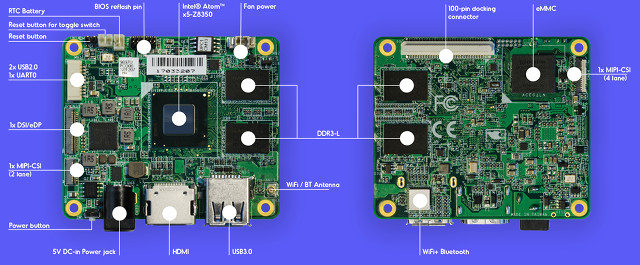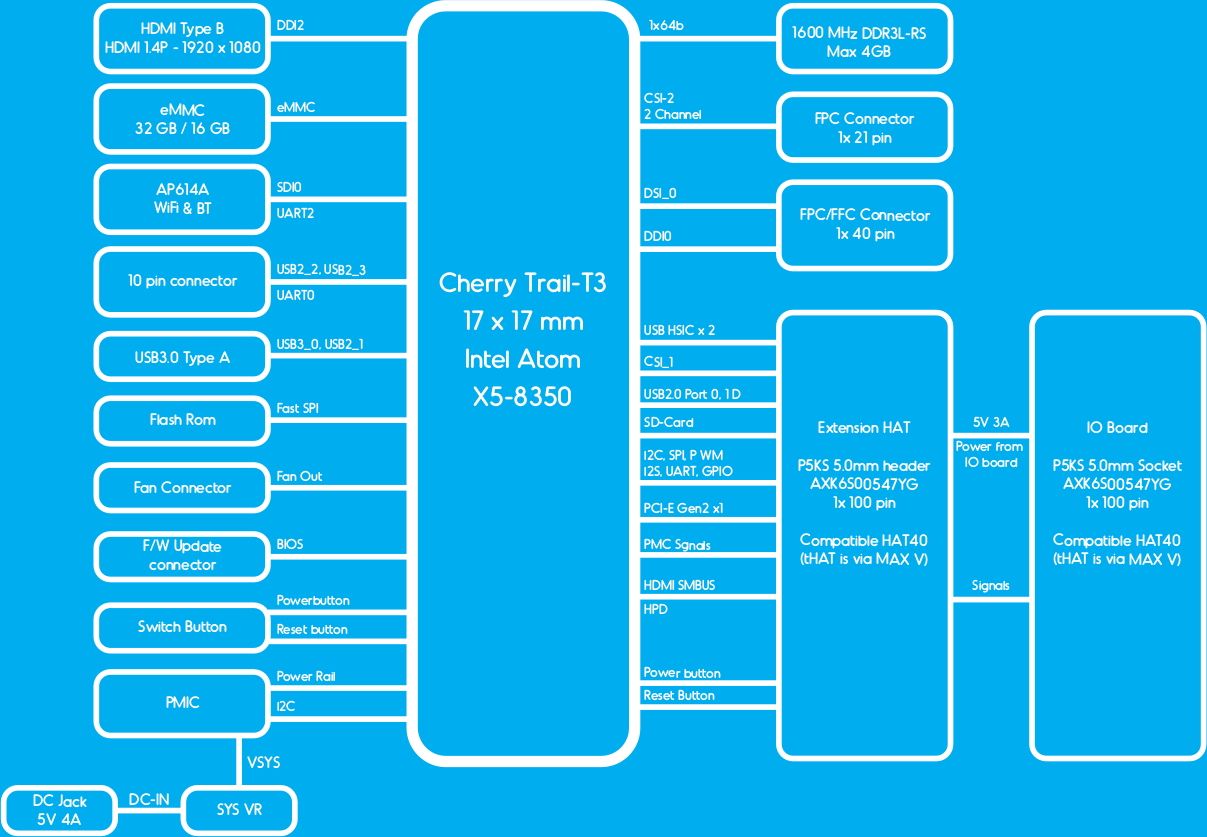The UP community has already launched Intel Cherry Trail and Apollo Lake boards in the past with UP Board and UP2 (squared) boards, and they are now about to launch a cheaper and smaller board called UP Core powered by Intel Atom x5-Z8350 processor with to 1 to 4GB memory, up to 64GB eMMC flash, HDMI, USB 3.0, … and I/O expansion connectors.

UP Core specifications:
- SoC – Intel Atom x5-Z8350 “Cherry Trail” quad core processor @ 1.44 GHz / 1.92 GHz (Burst frequency) with Intel HD 400 graphics @ 200 / 500 MHz
- System Memory – 1, 2 or 4 GB DDR3L-1600 (soldered on board)
- Storage – 16, 32, or 64 GB eMMC flash, SPI flash ROM
- Video Output / Display – HDMI 1.4 port, full eDP (embedded DisplayPort) connector
- Audio I/O – Via HDMI, and I2S
- Connectivity – 802.11 b/g/n WiFi @ 2.4 GHz, Bluetooth 4.0 LE (AP614A)
- USB – 1x USB 3.0 host port, 2x USB 2.0 via header
- Camera I/F – 1x 2-lane MIPI CSI, 1x 4-lane MIPI CSI
- Expansion
- 100-pin docking connector with power signals, GPIOs, UART, SPI, I2C, PWM, SDIO, I2S, HDMI SMBUS, PMC signals, 2x USB HSIC, CSI, and PCIe Gen 2
- 10-pin connector with 2x USB 2.0, 1x UART
- Misc – Power & reset buttons, RTC battery header, fan connector, BIOS reflash connector
- Power Supply – 5V/4A via 5.5/2.1mm power barrel
- Dimensions – 66 x 56.50 mm
- Temperature Range – Operating: 0 to 60 °C
The board will support Microsoft Windows 10, Windows 10 IoT Core, Linux including Ubilinux, Ubuntu, and the Yocto Project, as well as Android 6.0 Marshmallow.

If you look at the bottom right connector of the diagram above, we can see an extension HAT for the 100-pin docking port will be offered, as well as an IO board, both of which should be compatible with Raspberry Pi HATs with 40-pin connectors. But so far, I could not find details about the extension HAT, nor the IO board.
The UP core is coming soon to Kickstarter with price starting at 69 Euros with 1GB RAM, 16GB eMMC flash, and WiFi and Bluetooth. Other part of the documentation show a $89 price for the 1GB/16GB board, so maybe it’s the expected retail price out of the crowdfunding campaign. You’ll find a few more information on UP Core page, but we’ll probably have to wait for the Kickstarter campaign to launch to get the full details, especially with regards to add-on boards, and pricing for various options.
Thanks to Freire for the tip.

Jean-Luc started CNX Software in 2010 as a part-time endeavor, before quitting his job as a software engineering manager, and starting to write daily news, and reviews full time later in 2011.
Support CNX Software! Donate via cryptocurrencies, become a Patron on Patreon, or purchase goods on Amazon or Aliexpress




It should be a joke. No ethernet?. Are they trying to pester us with a nonsense board?, if there is just one USB out of the box they at least should include the 10 pin cable for that price.
I’m not convinced this board is going to do any more good than the regular UP board. It’s sad that these are much more expensive than buying chinese z8300 with everything ready to go.
For specs like 1GB + 16GB I would expect 50e more or less.
I’m amazed by the number of boards which ship without network connectivity, we’re in 2017, people have networks, NAS, laptops, we all want to connect these, we’re not at the MS-DOS era anymore where you installed your OS once for the whole life of your device. Another example of a totally useless piece of PCB+components unfortunately. And that’s sad because the original UP Board is quite a nice and well balanced device (though a bit expensive).
@nobitakun
@Willy
That board still has WiFi for network connectivity.
The fun thing is that I’ve just read a comment on social networks, where one guy commented about Orange Pi Zero Plus 2: “I like no useless ports (USB, Ethernet)”, so different people have different needs. 🙂
cnxsoft : @nobitakun @Willy That board still has WiFi for network connectivity. Well, WiFi’s performance, reliability and security are so poor compared to real networking that it’s generally limited to very basic stuff like reading e-mails and occasionally browsing the web. In short, what a tablet is made for. You can’t realistically use that for backups, to install your OS nor to repurpose your machine once it’s aging a bit and gets replaced. BTW, I do use a netbook to read e-mails and for occasional browsing, and when I back it up I connect the cable. The fun thing is… Read more »
The CPU has USB 3.0 and it is enough BW for USB to ETH converter, so ETH is not needed to save power I think.
@Willy
Ethernet on x5-Z8350 would require a PCIe to Ethernet chip. There will probably be an add-on board adding Ethernet through PCIe. But once you start adding add-on boards, price usually becomes much less attractive.
@Willy
Just plug in a RTL8153 (driver added upstream in Linux kernel with 3.14, performance sufficient to saturate GbE).
Meh, Rpi provides authentic legacy experience. Gotta love the single shared USB 2 host.
Willy : But a PC-like board has very limited use cases with no reliable networking these days in my opinion Well, that’s not entirely true but requires a completely different Wi-Fi installation compared to this cheap crap on SBC or this device. A friend doing tech support in a large agency just reminded me how less some users are used to deal with any cables any more. An art director complained the 2nd time within a few months his MacBook would be dead. In reality battery was completely discharged and the MacBook suspended to RAM. In the meantime the only… Read more »
@nobitakun
For my use-case, this board is a much better option than the other UP boards. I don’t need the Ethernet so it just gets in the way and makes the board taller and more expensive than it needs to be.
@Willy
Not everyone wants to use an UP board as a desktop replacement…
@tkaiser
Not to mention Macbooks are not a financially practical solution.
Who knows, up core may be good for something for some people.
@Debeko Well, I fear I’ve to disagree about MacBook price tags but that doesn’t matter (here). They are just an example for ‘Wi-Fi done correctly’ using more expensive/capable dual-band Wi-Fi chipsets paired with a sufficient amount of antennas and approriate TX power settings. In other words: Something completely different than ‘Wi-Fi’ known from SBCs or this board here and useable for fast 24/7 data transmission when AP situation is also sufficient. BTW: I didn’t comment on the UP Core itself, just wanted to point out that adding Gigabit Ethernet to an USB3 device is just adding either AX88179 or RTL8153… Read more »
Wonder if size is only reason they didn’t include an Ethernet port?
There are low-profile spring-based Ethernet ports if so.
Harley : Wonder if size is only reason they didn’t include an Ethernet port? This SoC has no native Ethernet and just a single PCIe lane which is routed to the ‘docking connector’ supposed to be combined with ‘HATs’. So either you change the whole concept (no PCIe on the connector but a PCIe GbE controller on the board) or you change the whole concept (add VL812+RTL8153 and a huge Ethernet jack to the board which means larger dimensions in every axis). While I don’t trust that much in the above diagram (HDMI Type B? Really? Ampak AP614A? Really?) I… Read more »
Just ordered an ORICO HR01-U3-BK which uses also VL812+RTL8153 for a few bucks less to test through 🙂
@tkaiser
“‘Wi-Fi done correctly’ using more expensive/capable dual-band Wi-Fi chipsets paired with a sufficient amount of antennas and approriate TX power settings.”
There are portable routesr, with antennas, that does that at a fraction of the cost. (Attach catX cable, anchor poblem solved.)
Cost is a big deal for many, its so bad where I live that a SBC was stolen several years ago (I don’t understand why, since it was less than $50.)
I cannot imagine if i have a mac and it becomes damaged or worse, stolen.
[ responding again, this morning my comment was lost on a server error ] tkaiser : When I do such Wi-Fi setups we graph the whole area with NetSpot first and then measure at the areas with less coverage. 10MB/s (Fast Ethernet speed) are required then with 2 antenna 802.11n and 802.11ac Wi-Fi (which isn’t that hard to achieve). Unfortunately 10 MB/s is considered very fast these days while it’s the speed we all had in 1999. Interestingly, Macs used to be praised for their ability to manipulate large images, but these days given they’re massively dropping ethernet, their users… Read more »
@Debeko
Anker, not anchor. Typo
Willy : Unfortunately 10 MB/s is considered very fast these days Only when comparing to this type of Wi-Fi we have to deal with SBC or cheap laptops (single antenna, 2.4GHz only). Those devices would show at the same location 500KB/s or less. 10 MB/s isn’t fast at all, that’s just the minimum value in the above example to justify no further AP optimizations. But 10 MB/s and ok-ish latency can be considered ‘good enough’ for many types of workers and workloads (yeah, even TimeMachine backup works flawlessly through Wi-Fi while still being able to use a wired connection for… Read more »